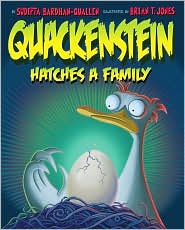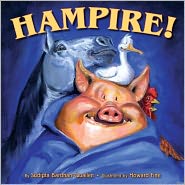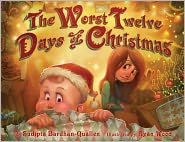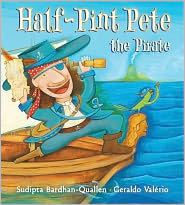The SBBT Interview with Sudipta Bardhan-Quallen

Today I'm thrilled to have Sudipta Bardhan-Quallen here at my blog, helping to kick of the 2011 Summer Blog Blast Tour in style. Sudipta got her start in publishing with nonfiction titles, including science fair titles for which she is uniquely qualified, being (as she is) a biologist by training, but she quickly branched out to biographies (Jane Goodall and Franklin Delano Roosevelt), as well as nonfiction books on topics ranging from AIDS to the Eiffel Tower.
Sudipta is best-known these days a picture book author, with quite a number of titles out in the world and more to come. I was happy to sit down with her and talk about her books and her process - especially since so many of her picture books are written in rhyme, and you all know how I love poetry!

1. You already have quite a number of picture books out in the world - from THE MINE-O-SAUR, about a dinosaur with sharing issues, illustrated by David Clark, to TIGHTROPE POPPY THE HIGH-WIRE PIG, illustrated by Sarah Dillard and THE HOG PRINCE, illustrated by Jason Wolff, to last fall's release, QUACKENSTEIN HATCHES A FAMILY, illustrated by Brian T. Jones. Your most recent release was CHICKS RUN WILD, illustrated by Ward Jenkins, which came out in January of this year, and in just two weeks' time, your next picture book, HAMPIRE!, illustrated by Howard Fine. I've just got to ask: what's the attraction to pigs and poultry?
It’s a theoretical attraction only, I promise - the thought of interacting with actual pigs and poultry is less than appealing, I assure you. Why the animals? Hmmm. It has something to do with the cuteness of the illustration possibilities, and with the easily available animal puns I can work with (or, go hog wild with!). But, honesty, I really like animal characters because there is a universal nature to them.

In any book, the main character is the reader’s proxy - the more we can identify with a main character, the more intriguing he becomes. Adults are able to use imagination to gloss over the gray areas - a petite woman can imagine herself as James Bond, a big, burly man can see the world through the eyes of a Jane Austen heroine - but kids don’t always have that sophistication. They are often so much more literal. When the character is a small blonde girl, it is hard for a dark-haired boy to imagine himself in her place. Replace the girl with a panda, however, and the child reader has no problem seeing the world through the main character’s eyes. Also, it is so much easier to show diversity using animals without running into political-correctness issues, or without hitting kids over the head with a message of diversity. Show a barnyard full of animals getting along and children get the message about diverse communities and the benefits of different points of view.
2. Your picture books tend to be written in rhyme - something I happen to adore, as do many readers. When you sit down to write a picture book, is the idea of writing in rhyme something that's fixed before you start, or something that evolves? Do you start by first writing out a script of sorts, then casting the whole thing into rhyme, or do you start with rhyme from the get-go?
Another tough question. I find, for me, the voice of the story is set at the beginning, so very quickly I know whether it will be in verse or in prose. I usually get a character in my head and then a few lines - if those lines rhyme, the story will be very hard for me to imagine in prose, and vice versa. For HAMPIRE, for example, I knew I wanted to incorporate the Hampire’s love of jelly rolls into the climax, and always had it in my head that there would be a pairing of “how Hampire filled his belly” with another line ending in the word “jelly.” I also knew I wanted to have some sort of indignation on the part of the Hampire expressed as “I’m no barbarian” and then have him reveal that he is, indeed, a “vegetarian.”
Even though the inspirational rhymes can be from any part of the story (and more often than not, represent either the ending or the climax), I cannot actually write those until I figure out the real beginning of the book. It is the beginning that dictates the meter and the rhyme scheme (or lack thereof), and I have to get that in place before I can do anything more than character sketching. And while I do not do a strict scripting, I typically know the beginning, and then the end - I actually write the middle of the story last. It’s like having a rough roadmap - I know the origin and the destination, and just have to figure out the journey.

3. HAMPIRE!, due out July 26, 2011 from HarperCollins, tells the story of Duck, trying to make it across the barnyard for a midnight snack, but running into a terrifying encounter with the Hampire, a (vegetarian) hog/vampire. In many respects, it's a "jump" story, somewhat reminiscent of Ruth Brown's beloved A DARK, DARK TALE or Jon Stone's THE MONSTER AT THE END OF THIS BOOK, both of which ratchet up the suspense as the pages turn by creating an expectation that something is coming - something ominous - only to let the reader off the hook at the end by disclosing something humorous. How did you come up with the concept for the book?
This book was a very long journey. Initially, I imagined the book to be the story of a misunderstood Hampire who just wanted to make friends, but the farm community’s preconceived notions about him prevented them from giving him a chance. But that story never worked - it was somehow too convoluted and didn’t come together with the magic required for publication. My fabulous editor at HarperCollins made a very simple yet brilliant suggestion - throw out everything I’d been working on for months and start fresh. Of course, at the time, it didn’t sound brilliant. It sounded cruel and unusual, actually.
So, when I went back to the drawing board, it seemed obvious that the theme of misunderstanding, or that you shouldn’t judge a book by its cover, could naturally yield itself to a faux-scary story where it wasn’t just the barnyard community who was unsure about the Hampire, but the reader as well. I’m very pleased with how the story came out, but honestly, it is Howard Fine’s fabulous illustrations that take this book from yet another “jump” story to a true piece of art. Bravo, Howard.
Was actual vampire lore important to you when writing it?
As for vampire lore, I’m afraid I fell back on every Hollywood stereotype of vampires - the swooping cape, the menacing presence. I just added a pig to it.

4. In November, your first Christmas title is due out: THE WORST TWELVE DAYS OF CHRISTMAS, illustrated by Ryan Wood. It recounts the horrors of dealing with a new sibling during the holidays, making use of the song structure of The Twelve Days of Christmas. Is this your first time working on a parody of a known song or poem? Did you find it more or less challenging than working on something "from scratch"?
This IS the first time I’ve done a parody, so to speak, and it was both easier and harder (which is a thoroughly unhelpful answer). It was easier in the sense that I knew exactly how the story should lay out because I mostly stayed within the context of the song. But what was harder was that there was no wiggle room - I couldn’t, for example, make it eight worst days of Christmas in the interest of page layout.
What is great, though, about finding a way to work with a known song is that people respond so favorably to something familiar. And if you can find a way to make the familiar fresh - well, that’s gold right there.

5. In January of 2012, HALF-PINT PETE THE PIRATE sets sail, illustrated by Geraldo Valério. Pete has only half a treasure map in his possession, making his quest a bit difficult - until he meets a female pirate with the other half of the map. You also will launch PIRATE PRINCESS, illustrated by Jill McElmurry - a piratical takeover of the picture book world, perhaps? (Alliteration almost entirely accidental.) How did this fascination with pirates come about - and what can you tell us about these forthcoming titles?
The fact that both pirate books will cast off in the same year is entirely coincidental, but great from a promotional point of view. As for my fascination - who doesn’t like a pirate? They swash and they buckle, they pillage and loot. Sounds like a deal to me.
Despite the piratical theme, the books are actually quite different. PETE is the story of a pirate who is in search of something to complete him - he just doesn’t know what he is searching for. As a pirate, he thinks it’s treasure, but with only half a treasure map, how can he ever feel whole? Of course, Pete turns out to be completely wrong about how he can achieve happiness, but it makes for an interesting journey.
On the other hand, PIRATE PRINCESS is about following your dreams - no matter how absurd they might be. And what could be more absurd than a princess who wants to be a pirate? Still, somehow Princess Bea finds her sea legs, so to speak - though not before some serious brushes with danger and seasickness . . .
SPEED ROUND:
Cheese or chocolate? Chocolate
Coffee or tea? Tea, but only if I have to. Pepsi is better, in a coffee mug if you need me to blend in.
Cats or dogs? Neither. I’m allergic to any pet my kids could have.
Favorite color? To wear: black. In every other context: pink
Favorite snack food? This changes, but currently, dark chocolate frosting, straight from the tub.
Favorite ice cream? Ben and Jerry’s Vanilla Caramel Fudge. Impossible to find, though.
Water or soda? Pepsi. Definitely.
What's in your CD player/on iTunes right now? A lot of pre-tween-friendly music: Taylor Swift, Katy Perry, Pink, Avril Lavigne. And then some totally-inappropriate-for-pre-tweens music, which I will not enumerate here.
What's the last movie you memorized lines from? Hmmm. I don’t know. Maybe Curse of the Black Pearl - Captain Barbossa’s classic, “the code is more what you'd call ‘guidelines’ than actual rules.” I use that logic every day to justify breaking the rules . . .
A big thank you to Sudipta Bardhan-Quallen for today's interview. Be sure to check out the other SBBT interviews today:
Tara Altebrando is with Colleen Mondor at Chasing Ray
Shirley Vernick is visiting Little Willow at Bildungsroman
Jack Ferraiolo is with Doret at The Happy Nappy Bookseller
